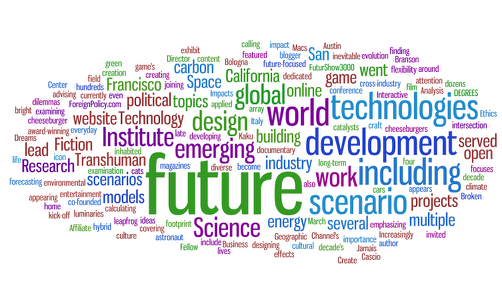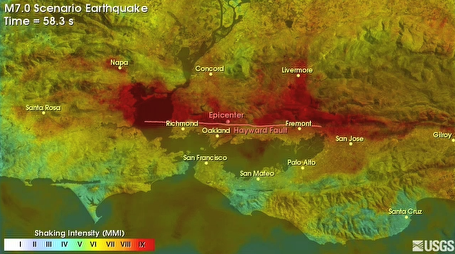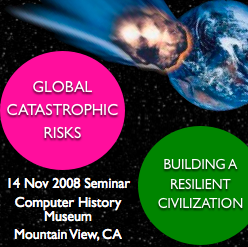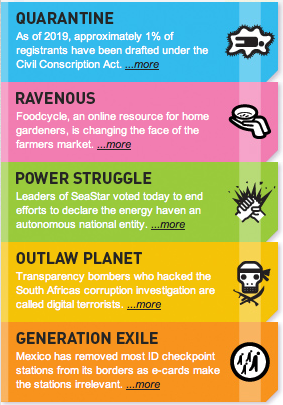Buckminster Fuller Challenge Press Release
(This is an amazingly cool project, one I'm deeply honored to be a part of. I know a lot of you out there have ideas that should be seen by this group -- the deadline for submissions is November 7, so get to work.)

THE 2009 BUCKMINSTER FULLER CHALLENGE JURY ANNOUNCED
OCTOBER 31, 2008 NEW YORK CITY — The Buckminster Fuller Institute (BFI) has announced the members of the 2009 Buckminster Fuller Challenge jury. The jury will select the winner of the Challenge, to be announced to the public in May 2009. The jury will confer the prize at a public event at the Museum of Contemporary Art, Chicago in June 2009.
The members of this year’s jury are:
ADAM BLY, named a Young Global Leader by the World Economic Forum, Bly is a powerful voice for science literacy in the 21st century. Founder and Editor-in-Chief of Seed magazine and Seed Media Group, winner of the 2006 Independent Press Award for Best Science and Technology Coverage;
JAMAIS CASCIO, pioneering futurist and scenario planner, Co-founder, Worldchanging.com; Director of Impacts Analysis for the Center for Responsible Nanotechnology; Fellow at the Institute for Ethics and Emerging Technologies; Research Affiliate at Institute for the Future; Scenario Design Lead for Superstruct, the “massively multiplayer forecasting game;”
EDIE FARWELL, respected systems thinker and sustainability expert, former Director of the Association for Progressive Communications and current Program Director of the Donella Meadows Leadership Fellows Program of the Sustainability Institute, which aims to apply systems thinking and organizational learning to economic, environmental and social challenges;
HELENA NORBERG-HODGE, A passionate activist for biological and cultural diversity and leading analyst of the impact of the global economy on cultures around the world. A linguist by training, she was educated in Sweden, Germany, England, the U.S., and speaks seven languages. Founder and director, International Society for Ecology and Culture; Co-founder, International Forum on Globalization;
JOHN AND NANCY JACK TODD (serving as a team), John Todd is a celebrated ecological designer and winner of the 2008 Buckminster Fuller Challenge, he has been named TIME’s Hero of the Planet among many other honors. Nancy Jack Todd is an accomplished author and the editor of Annals of Earth. Her most recent book is A Safe and Sustainable World: The Promise of Ecological Design;
GREG WATSON, a renewable energy expert, community organizer, and educator. Watson founded the Dudley Street Initiative, served as Massachusetts Commissioner of Agriculture, and currently serves as senior advisor to the Massachusetts Executive Office of Energy and Environmental Affairs.
“As the news gets more troubling, the challenge to each of us gets more critical. My father anticipated many of these challenges and addressed his life’s work to solving them, now we hope to identify others, all over the world, who are doing the same. This year’s jurors will bring their own extraordinary work and experience to bear to select a design science innovator who is pushing the boundaries of what is possible to help us face these challenges. We are honored to have their participation and begin this important work together,” said Allegra Fuller Snyder, Buckminster Fuller’s daughter and Chair of the BFI Board of Directors.
THE DEADLINE FOR ENTRIES IS MIDNIGHT (EDT) ON FRIDAY NOVEMBER 7TH 2008
For the call for entries, instructions for how to enter, reference materials, and much more, visit http://challenge.bfi.org
To read about last year's winning entry, visit http://challenge.bfi.org/winner_2008
To view entries to the 2008 Challenge, visit the Idea Index http://challenge.bfi.org/ideaindex
Watch the Buckminster Fuller Challenge movie http://challenge.bfi.org/movie
Contact: Matt Barron, Tel: 718.290.9283, Email: challenge@bfi.org





 Tired & busy with Superstruct. But check these out:
Tired & busy with Superstruct. But check these out: The
The 
